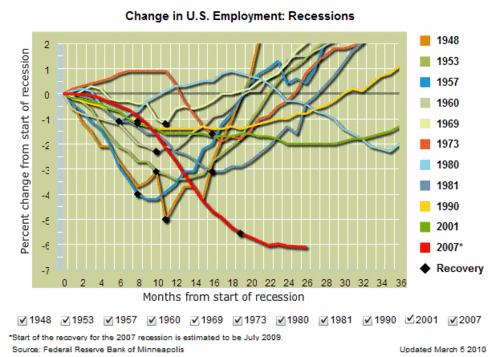26
Mar
2010
What Would a Reality-Based Economist Say?
Brad DeLong reproduces the below chart from Mark Thoma:
Neither of them offers commentary, but I’m assuming they would say, “See? We need more stimulus, duh. What more evidence will it take?”
But of course, someone like me would look at that and say, “Suppose we overlaid deficit-spending and growth in the Fed’s balance sheet. What more evidence do you need to see that the feds and Bernanke are making this thing worse? The only time in US history where we had more government ‘help,’ we had a decade-long slump.”








It actually looks like the red curve gives evidence that the stimulus worked in halting the recession. If the official date for the start of the recession is still Dec 2007, than the red line shows tha the inflection point in employment occurs right about month15, March 2009, right when ARRA was enacted. The official recovery, black dot, follows a few months later.
I don’t think that this is necessarily true, only guessing that this is why Thoma and DeLong posted it.
The stimulus did work in halting the decline in employment, output, prices etc. If you take a ton of cash parked in treasuries, or run the printing press, and throw it into the economy it will do something in the short-run. The question that interests me is how bad will the next crisis be. The one caused by artificially propping up the credit markets and failed institutions, and flooding the money/inter-bank markets w/o the needed debt liquidation and balance sheet rebuilding…
You can always stop a debt deflation crisis w/ a committed enough monetary/fiscal program. A currency crisis is another story though.
Three things:
(1) DeLong and Thoma titled their posts “One of these doesn’t belong” or something like that. So I don’t think they were saying, “Look at how the ARRA changed the trajectory of unemployment.”
(2) I wasn’t just talking government deficits, I was talking Fed action too. That happened well before March 2009.
(3) If we only had the red line to look at, sure you might think that the ARRA pulled us back from the brink. But that chart shows ten previous recessions, in which there was nothing in the same ballpark as the ARRA (or TARP etc.), and unemployment turned around much more quickly.
Now it’s true, DeLong et al. can say, “Duh, the patient was sicker in this case, and that’s why we needed to use stronger medicine. I suppose you could ‘prove’ that chemotherapy is ineffective by looking at people who don’t have cancer. Moron.”
But that’s what we’re arguing, whether deficit spending is medicine or poison. And if I wanted to make an empirical argument that it’s poison, wouldn’t I be sitting pretty with the above chart? Isn’t that exactly what the lines would look like, if the Austrians were right?
In contrast, if the Keynesians / Friedmanites are right, we have to assume that there is an unobservable exogoneous “bad economy situation” driving the 2007 recession worse than the previous 10.
Oops one more thing to clarify: DeLong et al. could say, “‘Unobervable bad economy situation’? What are you a nincompoop? You’re saying you didn’t realize the economy was really bad back in winter 2008?”
But remember, Christina Romer et al. apparently didn’t know how bad the economy was back in winter 2008. That’s why they thought without the ARRA, unemployment might almost hit 9%. Then when they got ARRA and unemployment broke 10%, they said, “Gosh we didn’t realize how weak the economy was. George Bush screwed us over harder than we knew at the time.”
So that’s what I mean, that the economy just keeps getting worse and worse. On paper the loss in housing wealth shouldn’t have led to a worldwide collapse. DeLong thinks that observation is a striking blow against Austrian business cycle theory, but it is also consistent with the claim that the various “rescue” measures by governments and central banks have made things worse.
Remember it’s actually not correct to say, “Austrians think the Fed caused the Great Depression.” Austrians think the Fed caused the stock market crash of 1929. But if Hoover had actually been a liquidationist and listened to Mellon, there would have been an awful recession from 1929-1930 or maybe early 1931. But then we would have had a Roaring ’30s.
Either someone tell me they plan to integrate deficits and credit expansion, or someone tell me how I might go about doing it, because it seems a chart like that could be an extremely powerful information-tool.
A realist economist would say the government has been declaring the recovery earlier then it should, in hopes the animal spirits will ignore all facts and spend again. Look at the 2001 line, it’s not much better then the 2008’s. The 1990’s is also looking pretty shitty.
Well either for the last three recessions the USA government has consistently been under funding their Keynesian spending, Keynesian spending is becoming less useful, or the FED’s are trying to deny a problem exist and declaring a false bottom, so the recession ends sooner, and the recovery just drags on and on and on.